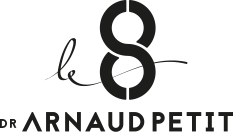The upper body lift
Body surgery
Many patients feel uncomfortable with their excessive skin rolls in the back area, which are visible underneath their clothes. In female patients, their bulging is accentuated by the brassiere, which cause difficulty in getting dressed. Those excessive skin rolls reveal a secondary cutaneous excess mostly due to massive loss of weight or to aging.
The upper body lift is a little-known procedure which is not wide-spread in France. Dr. Petit devoted his thesis to this innovating topic with Dr. Jean-François Pascal, one of the body lift world leaders.
This procedure enables to treat the dorsal rolls extending by lateral rolls above the waist, and sometimes by submammary abdominal rolls. Moreover, the upper body lift infers a reduction around the waist line.
These upper body cutaneous skin excess cannot be corrected by the usual techniques of liposuction, tummy tuck with an umbilical transposition or lower body lift.

Procedure steps
- Dr. Petit will ask you a number of questions about your medical and surgical histories (especially bariatric surgery: by-pass, sleeve gastrectomy, gastric ring), your weight and your size as well as your tobacco consumption.
- He will listen to you in order to understand your discomfort as well as your expectations in the back regions.
- He will examine your upper body rolls and more generally your silhouette, in order to suggest the most appropriate surgical strategy relating to your anatomy and to your request.
- Dr. Petit will provide information on the scar positioning, treatment process and procedure limits, post-operative recoveries as well as main risks, so as to make an informed decision.
Procedure limits
The upper body lift does not correct the dorsal excessive skin rolls located beneath the waist and in the lower abdominal apron area. These will imply a lower body lift.
Good candidates for an upper body lift are those
- With circumferential cutaneous fat excess in the upper body area
- With aesthetic and functional unease.
- Accepting the scarring price
- And having understood the procedure limits.
General pre-operative instructions relating to aesthetic surgery
- Smoking cessation 1 month before and after the procedure.
- Discontinuation of medicines which increase bleeding 10 days before and after the procedure: aspirin, anti-inflammatory and anticoagulant medicines, vitamin E.
Specific pre-operative instructions relating to the silhouette surgery
- To be at your ideal and stable weight for at least 6 months before the procedure.
- Oral contraception discontinuation 1 month before the procedure in order to reduce the risk of venous thrombo-embolism (phlebitis and pulmonary embolism).
- Purchase of a compression garment.
Procedure stages
Pre-operative markings are performed by Dr. Petit before the procedure.
The operation is performed under general anesthesia, with hospitalisation from one to two nights at the Surgical Center.
It consists in removing the cutaneous fat excess in the upper body area circonferentially, and to tighten the back skin, the waist and the upper part of the abdomen.
There are several variations of the upper body lift according to your anatomy (back lift, lateral thoracoplasty, reversed tummy tuck), having as a common point a more or less long-term scar hidden within the bra line.
The skin closure is performed with subcutaneous resorbable sutures.
A dressing modeling the back is performed at the end of the procedure.
What to expect after surgery
The upper body lift is a little or moderately painful procedure. Pains are soothed by analgesics.
Ecchymosis (bruises) are classical and last 2 à 3 weeks after the procedure.
An œdema (swelling) is constant and of varying lengths, diminishing within a few months.
Daily nursing care after your shower with a soft soap are necessary during 15 days.
Three preventive measures against phlebitis are established after the procedure: the affected leg elevated as well as the walk, the wearing of compression stockings and the daily injection of an anticoagulant (medicines which thin the blood) during 15 days.
It is recommended to wear a compression garment during 1 month to reduce the post-operative oedema.
The progressive resumption of daily activities is possible within the first post-operative days.
The resumption of professional activities can be done within 2 à 3 weeks after the procedure, and depends on the operative gesture performed and on the patient’s work.
The resumption of sports activities is authorized within 6 weeks after the procedure.
Procedure risks
The potential complications of an upper body lift are weak, provided that it is performed by a surgeon specialized in this type of procedure.
Main risks are the following
In the first hours following the surgery :
- a haematoma (blood pooling), a rare complication requiring a revisionary process in order to drain it.
In the post-operative month:
- Healing problems, resulting in one or several localized disunities (opening of the scar) requiring a directed healing.
- A seroma (collection of fluid), requiring a drainage in consultation.
- Transitory troubles of skin sensitivity.
- An infection, a cutaneous neurosis: rare complications.
- A phlebitis, a pulmonary embolism: exceptional complications with the preventive measures established previously.
In the long term:
- A scar expansion: the most frequent complication in the back region, requiring a revisionary procedure.
- A pathological scarring (hypertrophic scars or keloids).
Long-term outcome
The final result relating to an upper body lift is reached between 3 to 6 months after the procedure, once the post-operative edema has disappeared.
The scar initially is inflammatory (red and swollen) throughout the first months, then it will fade progressively without disappearing. The final aspect of your scar is not predictable and will be known at the end of the cicatricial maturation (between 1 and 2 years after the procedure).
This result is stable and long-lasting except in cases of fluctuations in body weight or pregnancy.
The upper body lift is a reliable and an efficient procedure which reshapes the upper body. It generates a huge aesthetic and functional benefit, which accounts for a high degree of satisfaction of the patients using this surgery.


